Anklet and Irons
At Thrissur Pooram.
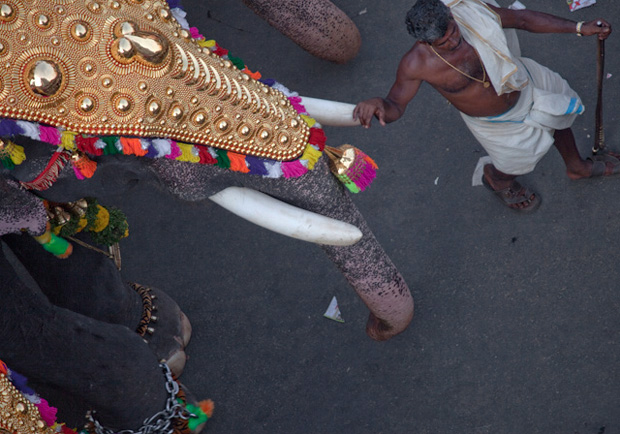
At Thrissur Pooram.

I started working on a post on my observations and interactions with people of Ladakh. There are so many memorable incidences that I realized it is not going to end in a short post. Here is Part I.
A grandmother and a little girl were part of the family with whom I stayed in Leh. If there was one thing common between the two, it is a toothless smile that warmed our hearts. While grandmother’s smile had a reassuring feel to it, the bubbly little girl charmed us with her innocence. In the two months I spent in Ladakh, I found an abundance of effortless smiles. People smiled at their kith and kin and even strangers unpretentiously and greeted each other with a warm ‘julley’. Sometimes there is such a deep acceptance in their smile that you almost feel part of their family.
The smiles and goodwill were often seen in action too. I was initiated to the tolerance of Ladakhis as soon as I landed in Leh. With no money in the pocket and the ATMs in town not functioning, our cab driver Sirin did not make a fuss but agreed to take his payments next day. The next morning when we headed out to the market to begin our first day at Leh, our host Wangyal did not just give directions, but escorted us half-way through the maze of alleys to ensure that we don’t get lost.
After staying at Wangyal’s guesthouse for good ten days, we even left without making payments and did not have to worry much about leaving our hosts unhappy. We had to check out from the guesthouse before dawn to catch an early morning bus to Nubra Valley. When the attempt to wake up the hosts was not successful, we decided to leave and get to the bus-stop in time. We left a note instead, saying that we are coming back in a week’s time to make payments. I called Wangyal later in the day to apologize, expecting a disgruntled person speaking at the other end. But he seemed least bothered and had no complaints to make.
Later during our journeys in Ladakh, we have always had people helping us in situations of trouble. Even immigrants who lived in Ladakh for a long time have acquired this trait from the locals. Once when our rented bike was punctured and we were looking for help to get it back to Leh, an army officer and a truck driver went out of their way to help us. Another truck driver and his associates worked with us for more than an hour to get our bike started when it gave way mid-way to Pangong Lake. A mechanic who came on the way later pitched in his efforts to ensure that we were back on the road. Without these people, our journeys in Ladakh would have been a lot more difficult.
If there is one thing that catches a traveler’s eye on the first visit to Ladakh, it is the easy-going approach to life that Ladakhis have. You rarely see them complaining or worried about something, even when things go wrong. Rare are the times you see them sullen or fighting with each other. It is not that you never see this happening, I did encounter some one who seemed unhappy with himself and another one who got into a small skirmish with us. But most people are so cheerful that you would like to be in their shoes.
Visitors and anthropologists often associate this attitude to their upbringing, the traditional community life lead by Ladakhis, their religious nature and the harsh terrain they live in. In a typical Ladakhi Village not yet affected by modern living, the family works together and lives together, interacting continuously through the day. Families co-operate with rest of the village get difficult tasks completed, such as building a house or ploughing the farm. Children join the family in these tasks very early in life and learn to take up responsibilities. Buddhism teaches them to be tolerant and compassionate towards everyone. Interestingly, the most demeaning thing in Ladakh is to call someone short tempered!
Ladakh’s cheerful nature is infectious and easily rubs into people visiting the region. No wonder that I long to go back there again.
Spituk was the first monastery I visited in Ladakh. A few pictures from the visit.
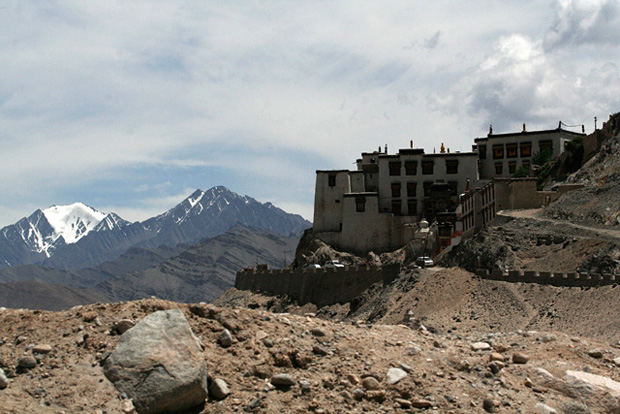
Spituk Monastery, like all monasteries in Ladakh, is located on a hill overlooking the village. River Indus flows behind the monastery, beyond which are the tall mountains capped with ice. On the other side of Spituk is a very different landscape where the wide valley of Indus is used in constructing the Leh Airport and the army installations. At less than 10km from Leh, Spituk it is almost ready to be consumed by the expanding town.
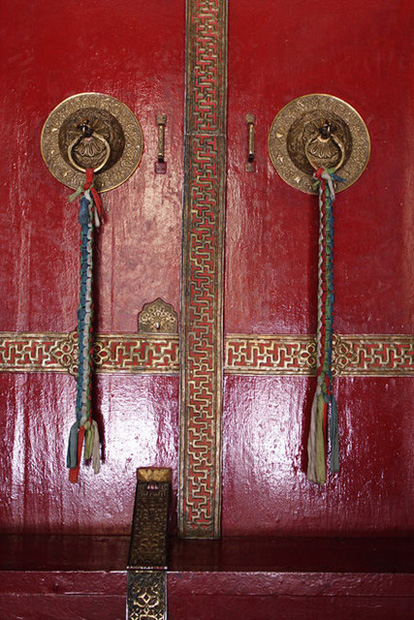
The colourfully painted doors of dukhang (prayer hall) in Spituk Monastery.
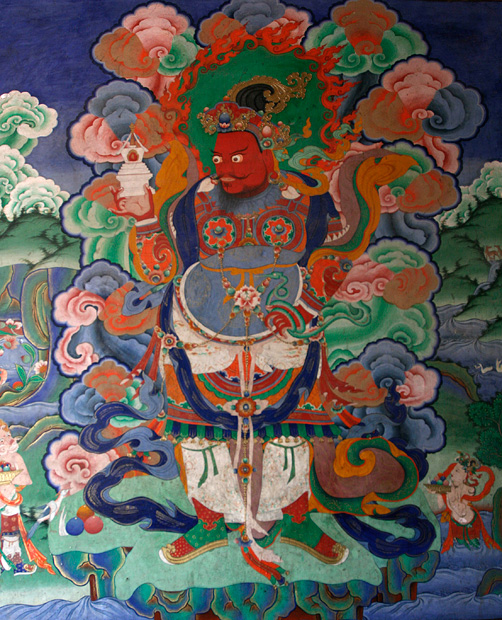
A mural of Virupaksha (also called Chanme-Zang), the lord of the west direction. The front wall of the prayer hall in every monastery is usually painted with images of guardians dieties of four directions.
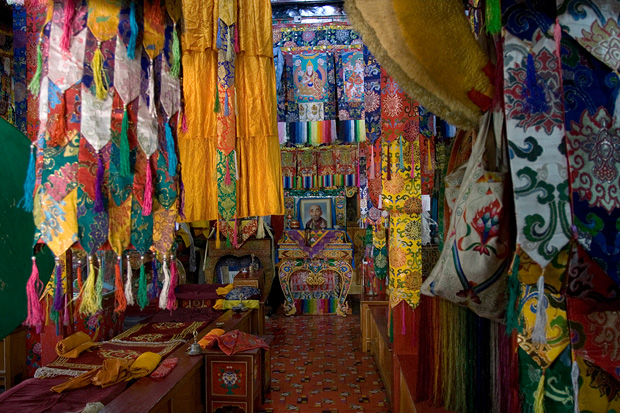
Colourful decorations in the prayer hall of Spituk Monastery.
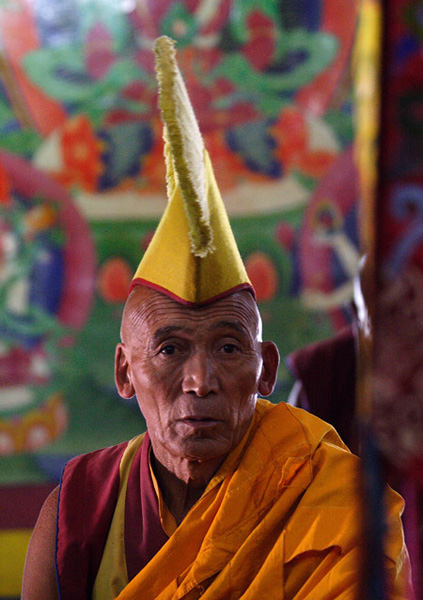
A monk wearing the traditional yellow hat of the gelug pa lineage at Spituk Monastery.
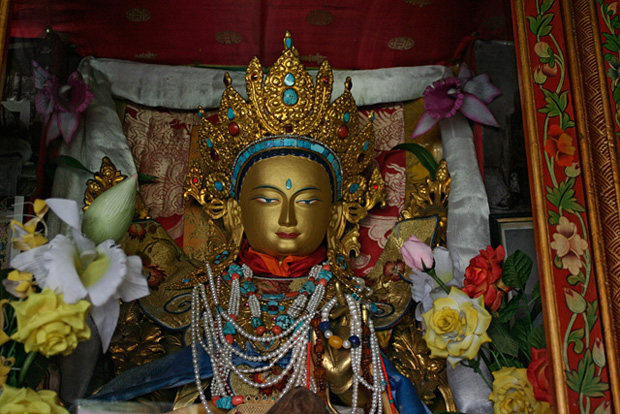
A statue of Tara (also called Dolma), a female Bodhisattva. Spituk Monastery has a room dedicated to images of Tara, called Dolma Lhakhang or the Temple of Tara
Powered by sciolism 2019 and WordPress.